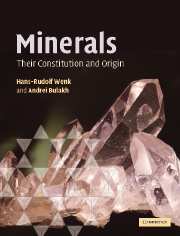Book contents
- Frontmatter
- Contents
- Preface
- Acknowledgments
- Figure credits
- Part I Structural features of minerals
- Part II Physical investigation of minerals
- 7 Experimental studies of crystal structures. X-ray diffraction
- 8 Physical properties
- 9 Optical properties
- 10 Identification of minerals with the petrographic microscope
- 11 Color
- 12 Additional analytical methods
- 13 Mechanical properties and deformation
- Part III Variety of minerals and mineral-forming processes
- Part IV A systematic look at mineral groups
- Part V Applied mineralogy
- Appendices
- Glossary
- References
- Index
- Plate section
- References
9 - Optical properties
from Part II - Physical investigation of minerals
- Frontmatter
- Contents
- Preface
- Acknowledgments
- Figure credits
- Part I Structural features of minerals
- Part II Physical investigation of minerals
- 7 Experimental studies of crystal structures. X-ray diffraction
- 8 Physical properties
- 9 Optical properties
- 10 Identification of minerals with the petrographic microscope
- 11 Color
- 12 Additional analytical methods
- 13 Mechanical properties and deformation
- Part III Variety of minerals and mineral-forming processes
- Part IV A systematic look at mineral groups
- Part V Applied mineralogy
- Appendices
- Glossary
- References
- Index
- Plate section
- References
Summary
Some physical background
Optical properties are a striking expression of the anisotropic internal structure of minerals. The best way to convince yourself that this is true is to examine a thin section of a rock (a 20–30 μm thick slice, see Chapter 10) in a petrographic microscope with polarized light and compare the effects with those from a plain glass slide. The glass slide appears dull black, whereas the rock, composed of crystals, displays an intricate color pattern that changes as the thin section is rotated (see e.g., Plates 2 and 3). The change in optical properties with orientation highlights anisotropy of crystals. Indeed, the interaction of light with crystals is directional, and this lends itself to a sophisticated microscopical analysis that is widely used by mineralogists and petrologists. The optical properties of minerals are characteristic and serve for mineral identification. The subject of optical mineralogy is extensive and is dealt with in many excellent books (for a partial listing, see “Further reading” at the end of this chapter). Here we provide merely a brief overview of the most important principles of crystal optics to help in understanding some of the optical features of minerals. This discussion is followed in Chapter 10 by an introduction on how to analyze minerals with a petrographic microscope.
Like X-rays (see Chapter 7), visible light is electromagnetic radiation resulting from the interaction of an oscillating electric field E and an oscillating magnetic field H (Figure 9.1).
Information
- Type
- Chapter
- Information
- MineralsTheir Constitution and Origin, pp. 156 - 180Publisher: Cambridge University PressPrint publication year: 2004
